It looks like you're using an Ad Blocker.
Please white-list or disable AboveTopSecret.com in your ad-blocking tool.
Thank you.
Some features of ATS will be disabled while you continue to use an ad-blocker.
30
share:
This was one of the stories that got me interested in conspiracies when I was younger. It also made me realise how twisted and corrupt government was
back then... and still is today.
this story was so very interesting to me at the time because the place called "love canal" is actually not far from where I live. Now I am Canadian, and this disgusting tragedy happened in New York, but we share the same water that was polluted by the perpetrators of this crime against humanity.
I live where the green circle is... the red diamond is where the love canal is located, and the Niagara river is right on the boarder of Canada and the US... as I've said, we share the same water
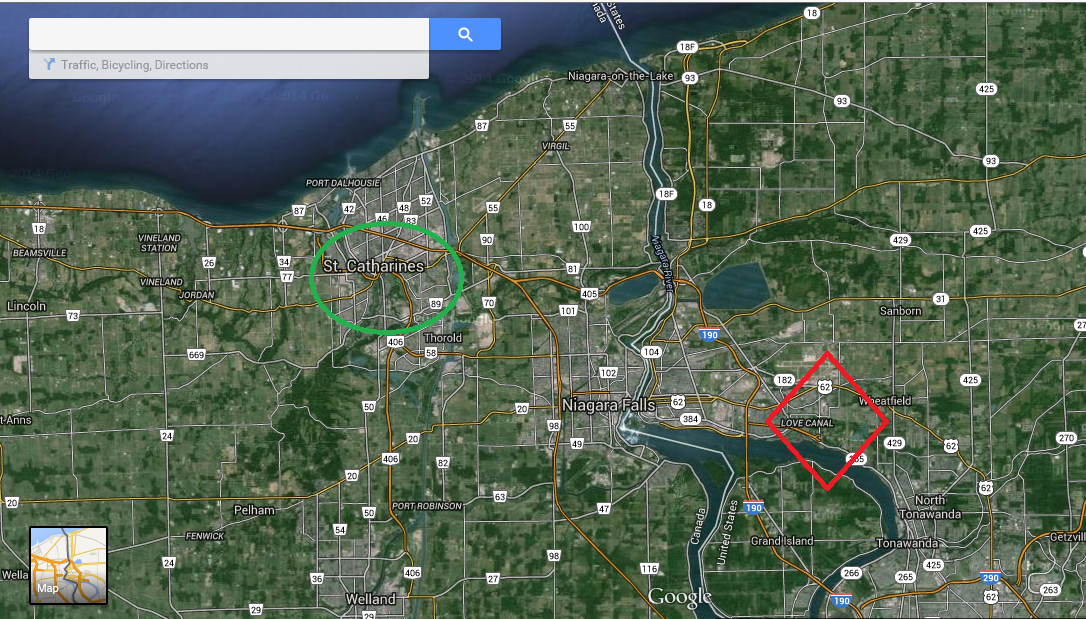
A bit of background info on this subject.... IF you will..
Around 1946 there was a rather large population increase in the area because many soldiers were returning from World War 2. In the time just after the dumping of all these chemicals happened, the land was sold to land developers who in turn built houses on and around this land... it was just your regular run of the mill suburb with a nifty little secret under the ground.
In 1953, Hooker sold the canal to the Niagara Falls school board for next to nothing. Clearly they had to tell the school board of what was underneath the ground, but it was decided that building a school would be perfectly fine, as long as it didn't have a basement... but of course a playground would be ok, because they obviously didn't realise the builders would have to stabilise the equipment by digging into the ground, which was exactly what they weren't supposed to do... How they figured they would build the foundation to the school without digging... who knows. The site was supposed to be covered with several feet of clay to contain the chemicals, but later testing found only a few inches of soil covering metal drums in some areas.
a sociologist named Adeline Levine wrote a book on the subject and interview one of the ladies that grew up in the area who described some of the things she saw as a child
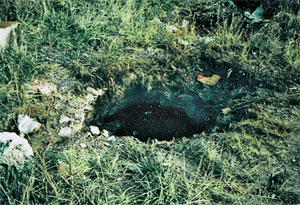
I recall some of the stories I've read about the love canal as well... colourful chemical slicks running down the sides of the street in a heavy rain storm. There was even one story that I read saying that rocks in the area would literally smoke and smolder, and at times even explode!
Many health complains started turning up after a while, everything from birth defects to mild and serious burns... eventually a laundry list of health problems arised from the residents in the area. Some people couldn't use their basements at all because of these chemicals under the ground, toxic gases were spewing into peoples basements. In some cases a multicoloured ooze was reported seeping right through the concrete in peoples basements.
Finally the U.S. EPA and the New York Department of Environmental Conservation stepped in to test the air in basements of homes bordering the canal. People were advised to stay out of their basements. In many cases they found toxic levels of benzene 6 times higher then the federal limit... but the residents of the area owned homes and many could not afford to just abandon their homes. The banks certainly wouldn't help, so many people were quite literally stuck there.
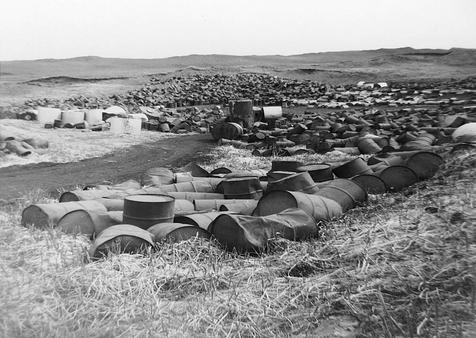
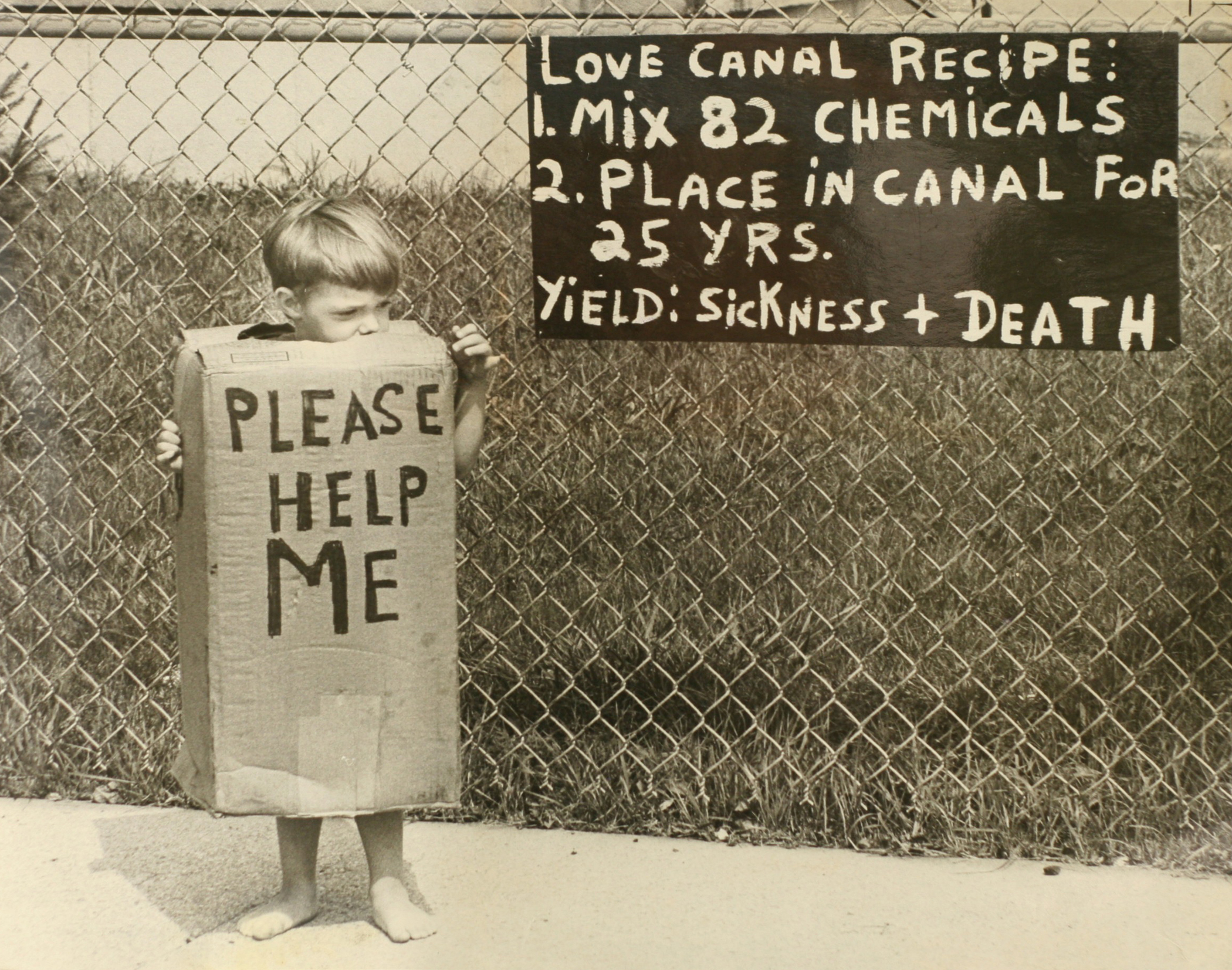
imagine living this close to buried toxic waste... and not even knowing about it?
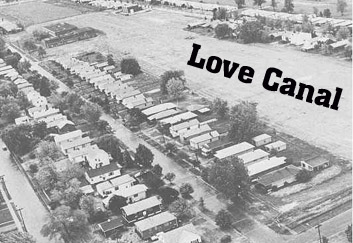
And all this is perfectly situated right beside the Niagara river... take a guess where all those chemicals in the area have ended up after leaking out of the ground for decades...
A disgustingly wonderful story... but it doesn't end there...
Continued...
this story was so very interesting to me at the time because the place called "love canal" is actually not far from where I live. Now I am Canadian, and this disgusting tragedy happened in New York, but we share the same water that was polluted by the perpetrators of this crime against humanity.
I live where the green circle is... the red diamond is where the love canal is located, and the Niagara river is right on the boarder of Canada and the US... as I've said, we share the same water

A bit of background info on this subject.... IF you will..
Love Canal got its name from William T. Love, an entrepreneur and developer in Niagara Falls in the late 1800s. The electrochemical industry was drawn to the waterfall because it generated cheap hydroelectric power to feed its electricity-hungry manufacturing processes. And Love had a deal for them. He would build an industrial city, called "Model City" in the optimism of the day, centered on a canal connected to the Niagara River. He started digging in the 1890s.
Love's dream collapsed after the inventor Nikola Tesla came up with alternating-current electricity, which could travel farther by wire than direct current and obviated the need for factories to locate near the falls. The canal Love left behind became a half-mile-long swimming hole. But later, Elon Hooker decided to locate his electrochemical company near the canal, and the business eventually became the largest industrial enterprise in town, making chemicals and plastics.
In 1941, Hooker Chemical (which underwent various name changes and was later bought by Occidental Chemical Corp.) decided to use Love's canal for waste disposal. The canal was nearby in what was then a sparsely populated area, and the soil was largely composed of impermeable clay that Hooker's engineers thought would contain the chemicals well. From about 1942 to 1953, Hooker disposed of thousands of tons of chemical waste there, some of it loose and some in metal drums.
No one knows exactly what Hooker dumped, but perhaps one-quarter of the waste was benzene hexachloride, the main component of the pesticide lindane, a neurotoxin. There were chlorobenzenes (used in the synthesis of DDT) and dozens of other organic chemicals, many of which were known to be toxic. The waste also contained an estimated 120 lb of 2,3,7,8-tetrachlorodibenzo-p-dioxin, commonly called dioxin, which is a by-product of trichlorophenol manufacture. At the time dioxin was buried at Love Canal, it was not thought to cause disease, but it is now known as one of the most carcinogenic chemicals in the world. In those days, Hooker's landfill methods were legal and quite common; companies were allowed to dump waste in almost any manner, as long as they owned the land on which they dumped.
Around 1946 there was a rather large population increase in the area because many soldiers were returning from World War 2. In the time just after the dumping of all these chemicals happened, the land was sold to land developers who in turn built houses on and around this land... it was just your regular run of the mill suburb with a nifty little secret under the ground.
In 1953, Hooker sold the canal to the Niagara Falls school board for next to nothing. Clearly they had to tell the school board of what was underneath the ground, but it was decided that building a school would be perfectly fine, as long as it didn't have a basement... but of course a playground would be ok, because they obviously didn't realise the builders would have to stabilise the equipment by digging into the ground, which was exactly what they weren't supposed to do... How they figured they would build the foundation to the school without digging... who knows. The site was supposed to be covered with several feet of clay to contain the chemicals, but later testing found only a few inches of soil covering metal drums in some areas.
a sociologist named Adeline Levine wrote a book on the subject and interview one of the ladies that grew up in the area who described some of the things she saw as a child

We kids would go over [by the canal], and you would see a bubble form—oh, I would say about 9 to 12 inches in diameter," she says. Kids would quickly gather up stones to throw into the chemical-filled hole. They didn't know it, but the bubbles formed when a metal drum of chemicals rusted through and broke underground. The soil above it would collapse into the drum and force chemicals to the surface; then the sides of the hole would close back up after a minute or two. "It would open up sort of in slow motion, and then it would break, like a bubble would, and then you would throw the stones in. It was a game we played." The kids didn't think about whether it was dangerous. "As a child, you shouldn't have to."
I recall some of the stories I've read about the love canal as well... colourful chemical slicks running down the sides of the street in a heavy rain storm. There was even one story that I read saying that rocks in the area would literally smoke and smolder, and at times even explode!
Many health complains started turning up after a while, everything from birth defects to mild and serious burns... eventually a laundry list of health problems arised from the residents in the area. Some people couldn't use their basements at all because of these chemicals under the ground, toxic gases were spewing into peoples basements. In some cases a multicoloured ooze was reported seeping right through the concrete in peoples basements.
Finally the U.S. EPA and the New York Department of Environmental Conservation stepped in to test the air in basements of homes bordering the canal. People were advised to stay out of their basements. In many cases they found toxic levels of benzene 6 times higher then the federal limit... but the residents of the area owned homes and many could not afford to just abandon their homes. The banks certainly wouldn't help, so many people were quite literally stuck there.


imagine living this close to buried toxic waste... and not even knowing about it?

And all this is perfectly situated right beside the Niagara river... take a guess where all those chemicals in the area have ended up after leaking out of the ground for decades...
A disgustingly wonderful story... but it doesn't end there...
Continued...
The area was declared to be "uninhabitable" years after the official evacuation in 1978...But there were still people that stayed behind who didn't
have the financial ability to up and leave their homes. After many lawsuits and testing of some of the local residents Occidental Petroleum
(Hooker's parent company) was found liable for the cleanup and settled a lawsuit with residents for $20 million. Of that, $3 million went to a
follow-up health study, $1 million to a medical trust fund, and what remained after the lawyers' take was divided among residents based on judgments
of individual health damages.
Lets have a look at the area today... What do we have here??
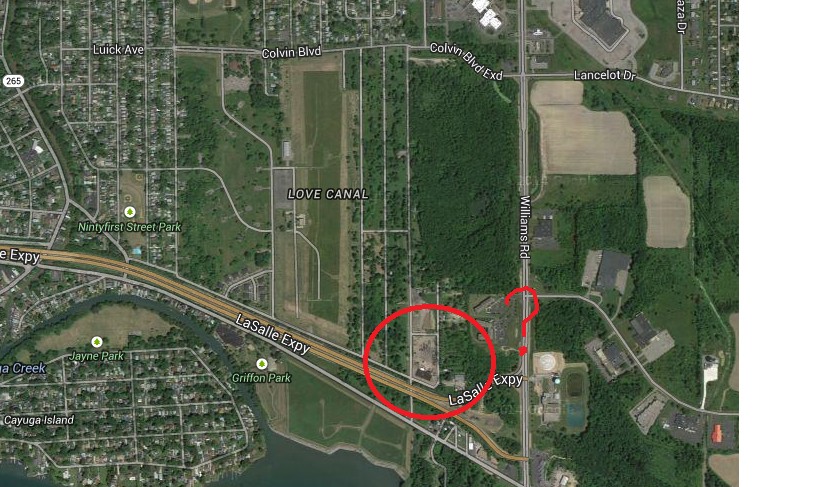
I always say google is your friend (kinda)... Lets take a closer look...
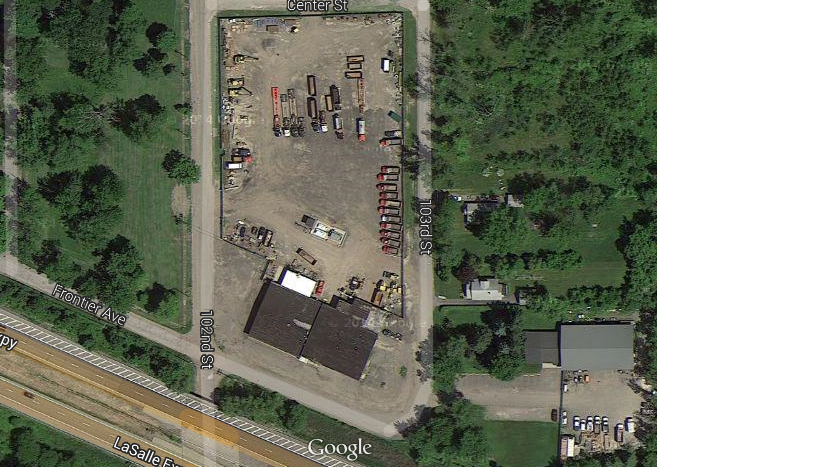
Dump trucks? Sorta makes ya wonder eh?
December 12th 2014
Love Canal waste being trucked to Canada?!?
Lovely... give the problem to another country... some brilliant moves by crafty politicians im sure...
Thanks guys!
A few days after this article showed up, another one appears stating the chemical waste will not be moved to its new home close to Sarnia Ontario
Love Canal waste will not come to Canada
So the question is.... IF its not coming to Canada to be disposed of....
Where are they planning on taking it now?
I wonder....
I hope we learn from this and other tragic situations one day... sigh
Thanks for reading everyone
Lets have a look at the area today... What do we have here??

I always say google is your friend (kinda)... Lets take a closer look...

Dump trucks? Sorta makes ya wonder eh?
December 12th 2014
Love Canal waste being trucked to Canada?!?
A notorious — and noxious — part of U.S. history is being moved to Canada.
At least 80 truckloads of toxic waste left over from the infamous Love Canal are being trucked to a facility in Corunna, Ont., near Sarnia, to be burned and buried.
The Love Canal is a U.S. neighbourhood built on a chemical dumping ground from the 1940s and 50s in New York state. The site contained chemicals and toxins dating from the Second World War. The waste coming to Canada, truckload by truckload, is from a smaller dump a few kilometres from the Love Canal. The smaller dump contained material that had been moved from the Love Canal site.
Lovely... give the problem to another country... some brilliant moves by crafty politicians im sure...
Thanks guys!
A few days after this article showed up, another one appears stating the chemical waste will not be moved to its new home close to Sarnia Ontario
Love Canal waste will not come to Canada
Days after it began arriving, toxic waste will no longer be shipped from the infamous New York state Love Canal to a waste processing plant in Ontario.
Clean Harbors, based in Massachusetts, said it has reversed its decision to burn and bury up to 100 truckloads of waste that was to be shipped to Corunna, Ont., southeast of Sarnia.
So the question is.... IF its not coming to Canada to be disposed of....
Where are they planning on taking it now?
I wonder....
I hope we learn from this and other tragic situations one day... sigh
Thanks for reading everyone
Thanks for the story. I live here, in the next suburb over (Amherst, by Ellicott Creek). I've never known exactly what went on there. I wonder if
this was part of the reason why both my parents got cancer (I'm only related to her). He lived out in Hamburg (30m south), and she lived here. At
the time, this was still Tonawanda.
a reply to: Akragon
This is nothing short of criminal. I have often used "building playgrounds at Love Canal" as a metaphor for useless governmental band-aids to conceal real true danger.
I grew up in a similar site area, also an EPA site...now have breast cancer. I contacted the county health department for that area, and got a reply which 1) denied (as I had charged) that I came from a cancer cluster) and 2) advised me to let my health care professionals that I had been exposed to high childhood levels of lead and arsenic.
Yeah. That's about as much of an official "Oh, was that wrong, shouldn't we have done that?" as you will see. And it goes on to this day.
This is nothing short of criminal. I have often used "building playgrounds at Love Canal" as a metaphor for useless governmental band-aids to conceal real true danger.
I grew up in a similar site area, also an EPA site...now have breast cancer. I contacted the county health department for that area, and got a reply which 1) denied (as I had charged) that I came from a cancer cluster) and 2) advised me to let my health care professionals that I had been exposed to high childhood levels of lead and arsenic.
Yeah. That's about as much of an official "Oh, was that wrong, shouldn't we have done that?" as you will see. And it goes on to this day.
a reply to: cronemel
The worst part is this happens all the time... especially in the past 30-40 years
I was just talking to my friend as I finished this thread... we both lived by an old factory that got torn down about 10 years ago... we played in the area for years, and I remember the stream that ran by the area...
it used to be all foamy and blue like ink... My buddy told me that a few of his family members worked at that factory when they were younger, and they would pour all the waste into the stream like it was nothing
what a world we live in... companies will do anything to save a buck or two...
at the expense of everyone
The worst part is this happens all the time... especially in the past 30-40 years
I was just talking to my friend as I finished this thread... we both lived by an old factory that got torn down about 10 years ago... we played in the area for years, and I remember the stream that ran by the area...
it used to be all foamy and blue like ink... My buddy told me that a few of his family members worked at that factory when they were younger, and they would pour all the waste into the stream like it was nothing
what a world we live in... companies will do anything to save a buck or two...
at the expense of everyone
edit on 12-2-2015 by Akragon because: (no reason given)
This is disgusting. You don't crap where you eat or drink. You just don't. People want to blame cigarettes or whatnot for cancer but I wonder if
practices like these aren't to blame. I mean, sure, the chemicals the put in the tobacco that they make cigarettes from aren't good for you at all
and cause health problems, including cancer but I don't think smoking is the sole cause. As for where they're taking that crap, I wouldn't doubt
that they tried a reservation. It's a common practice to truck the stuff onto the reservations for disposal.
Source
Source
Similar to a Duke Energy coal plant a little south-west of my location. They have been dumping their waste directly into the river, without even
processing it (to make it less toxic... for what it's worth). That river runs into the sound. The sounds are all connected to one another and the
ocean, and that's where my seafood comes from. That's where my family and I swim and have summer cookouts.
Thanks for posting this. I was not aware of the plan to move it.
I live about 10 miles north of love canal. I have 2 friends that live on Colvin right across the street on the north side of the canal. The houses were cheap, imagine that.
About 5 miles north of my house there is nuclear waste stored in Lewiston from the Manhattan project.
You have to be careful where you walk around here.
18 mile creek, about 15 miles NE of me has just been declared a toxic creek.
They really have no idea how they are going to clean that up, the sediment of the whole creek is toxic.
Such a shame, it is a beautiful area and the fishing is awesome, especially during the Salmon run.
So sad so little respect was shown to the environment by the government and Corporations.
There is no difference between the two, at least from where I live. Surrounded by their toxic mess.
I live about 10 miles north of love canal. I have 2 friends that live on Colvin right across the street on the north side of the canal. The houses were cheap, imagine that.
About 5 miles north of my house there is nuclear waste stored in Lewiston from the Manhattan project.
You have to be careful where you walk around here.
18 mile creek, about 15 miles NE of me has just been declared a toxic creek.
They really have no idea how they are going to clean that up, the sediment of the whole creek is toxic.
Such a shame, it is a beautiful area and the fishing is awesome, especially during the Salmon run.
So sad so little respect was shown to the environment by the government and Corporations.
There is no difference between the two, at least from where I live. Surrounded by their toxic mess.
a reply to: Akragon
What a great thread, It really caught my eye because we live where they were going to truck this slag and dispose of it.
From what I gather is they got quite a few trucks through until the uproar was stupendous in our area. You see they were moving it from one area of the Grate Lakes and depositing in another area of the Lake basins.
This time is was going to be buried much much closer to the water (St Clair River) This is and was insane. Thanks for keeping this front and center and all the work you put into this thread.
Regards, Iwinder
What a great thread, It really caught my eye because we live where they were going to truck this slag and dispose of it.
From what I gather is they got quite a few trucks through until the uproar was stupendous in our area. You see they were moving it from one area of the Grate Lakes and depositing in another area of the Lake basins.
This time is was going to be buried much much closer to the water (St Clair River) This is and was insane. Thanks for keeping this front and center and all the work you put into this thread.
Regards, Iwinder
Great thread. I'm glad that this is not being forgotten, and that there is still an interest in Love Canal.
I am a former Love Canal resident. I lived on Greenwald Ave in the "Declaration Zone (Ring III)" from 1976-1980. While we didn't suffer any of the health repercussions that other residents endured, especially those in Ring I and Ring II (The Uninhabitable Zone), others in my neighborhood weren't so lucky. The creek that ran right behind our property became contaminated from the run-off spewing through the storm drains and poisoned my neighbor (who used to fish in the creek) to the point where he eventually died. His high exposure to the dioxin that was in the chemical run-off, gave him some sort of advanced form of leukemia to which he never recovered. He was 7 years old.
I was very young at the time, but I remember going to the protests as a kid, and wearing signs that blasted the local government and Hooker Chemical's negligence. In fact, at the very beginning of the Disney hockey movie "Miracle" there is a shot of me as a little guy holding a sign that said "I Don't Want to Die for a Dollar" (The reference is to how much the City of Niagara Falls paid Hooker Chemical for the 93 acres of land and allowed a contractor to build a residential area on it.....$1.)
Our house was eventually bought by the State of NY, thanks largely to the part of Lois Gibbs who pushed the buttons of the state and the feds, to relocate families of Ring III in addition to the already implemented relocation plan for Rings I and II. Of course, we received below value of what we paid, but that's the MO of state spending. We later sued the City, State, and Hooker Chemical in the Love Canal Residents suit, again spearheaded by Lois Gibbs. We won, and got some money, but it still feels like we were had.
Driving back to Love Canal to see our old place during the 1980s and 1990s was both nostalgic and spooky. All of the houses in Ring I were demolished and bulldozed the the ground as well as all of the houses in Ring II - with the exception of two houses that some crazy old men lived in that didn't want to leave. Pretty much all of the houses in Ring III were all boarded up...lawns growing, damage to all of the roofs from neglect throughout all of the winters, and fences with signs everywhere. In my back yard, where my pool once sat, was a chain-linked fence with barbed wire on it, running halfway through my yard, with a sign that read "HAZARDOUS WASTE. KEEP OUT," warning people of the dangers of the contaminated creek behind it. Behind the fence, now consumed by the overgrowing woods, sat my first swing set...covered top to bottom with rust. The whole neighborhood resembled a scene from a post-apocalyptic movie set in the waste of an abandoned suburbia. Crazy stuff.
What irks me the most about the whole thing is that during the mid-late 1990s, the EPA and the state declared that the houses (what was left of them) in Ring III are now sitting in a "habitable zone" (The EPA began a cleanup of the area and build a new containment apparatus around the canal.) Some house flippers came in, prettied up all of the houses , and began selling them to people for 20% below their market value. Now, I know most sane people would never move there given the area's history, but you have to understand something about Niagara Falls, NY. It is part of the Rust Belt. Most of the city's inhabitants have left a long time ago, and most of the people that still live there are working-poor to lower-middle-class, at best. 45% of the city's residents are on some type of social assistance program. The prospect of being able to live the American Dream, and own a home, can overshadow good judgement. Keep in mind that these are not highly educated people. Plus, when you have the state and the EPA saying that "everything is contained/it is safe" many felt it was worth the risk.
Of course, it didn't take long for the new residents of Love Canal - now "Black Creek Village" - to start experiencing some of the same effects their previous occupants did 35 years earlier. Last that I read about it was that there is case pending from 2013.
I guess to sum it up, from someone who lived there, is that it's really just a story of greed, and the double standard when it comes to citizens and government. If I was walking down the street, and someone sold me a brand new Cadillac for $1, I might first stop and ask myself, "OK...what's wrong with this picture?" If I bought it, and was driving around and got pulled over by the cops, I'd be charged with GTA and tossed in jail. If I showed the cops the paper, said that I had purchased it, and that I paid $1 for it, the cop would laugh while he tossed me in jail. Why do the same sets of logic and legislature not pertain to the State of New York, and Hooker Chemical?
Oh yeah....Hooker Chemical had the suffix "Inc." at the end of it.
I am a former Love Canal resident. I lived on Greenwald Ave in the "Declaration Zone (Ring III)" from 1976-1980. While we didn't suffer any of the health repercussions that other residents endured, especially those in Ring I and Ring II (The Uninhabitable Zone), others in my neighborhood weren't so lucky. The creek that ran right behind our property became contaminated from the run-off spewing through the storm drains and poisoned my neighbor (who used to fish in the creek) to the point where he eventually died. His high exposure to the dioxin that was in the chemical run-off, gave him some sort of advanced form of leukemia to which he never recovered. He was 7 years old.
I was very young at the time, but I remember going to the protests as a kid, and wearing signs that blasted the local government and Hooker Chemical's negligence. In fact, at the very beginning of the Disney hockey movie "Miracle" there is a shot of me as a little guy holding a sign that said "I Don't Want to Die for a Dollar" (The reference is to how much the City of Niagara Falls paid Hooker Chemical for the 93 acres of land and allowed a contractor to build a residential area on it.....$1.)
Our house was eventually bought by the State of NY, thanks largely to the part of Lois Gibbs who pushed the buttons of the state and the feds, to relocate families of Ring III in addition to the already implemented relocation plan for Rings I and II. Of course, we received below value of what we paid, but that's the MO of state spending. We later sued the City, State, and Hooker Chemical in the Love Canal Residents suit, again spearheaded by Lois Gibbs. We won, and got some money, but it still feels like we were had.
Driving back to Love Canal to see our old place during the 1980s and 1990s was both nostalgic and spooky. All of the houses in Ring I were demolished and bulldozed the the ground as well as all of the houses in Ring II - with the exception of two houses that some crazy old men lived in that didn't want to leave. Pretty much all of the houses in Ring III were all boarded up...lawns growing, damage to all of the roofs from neglect throughout all of the winters, and fences with signs everywhere. In my back yard, where my pool once sat, was a chain-linked fence with barbed wire on it, running halfway through my yard, with a sign that read "HAZARDOUS WASTE. KEEP OUT," warning people of the dangers of the contaminated creek behind it. Behind the fence, now consumed by the overgrowing woods, sat my first swing set...covered top to bottom with rust. The whole neighborhood resembled a scene from a post-apocalyptic movie set in the waste of an abandoned suburbia. Crazy stuff.
What irks me the most about the whole thing is that during the mid-late 1990s, the EPA and the state declared that the houses (what was left of them) in Ring III are now sitting in a "habitable zone" (The EPA began a cleanup of the area and build a new containment apparatus around the canal.) Some house flippers came in, prettied up all of the houses , and began selling them to people for 20% below their market value. Now, I know most sane people would never move there given the area's history, but you have to understand something about Niagara Falls, NY. It is part of the Rust Belt. Most of the city's inhabitants have left a long time ago, and most of the people that still live there are working-poor to lower-middle-class, at best. 45% of the city's residents are on some type of social assistance program. The prospect of being able to live the American Dream, and own a home, can overshadow good judgement. Keep in mind that these are not highly educated people. Plus, when you have the state and the EPA saying that "everything is contained/it is safe" many felt it was worth the risk.
Of course, it didn't take long for the new residents of Love Canal - now "Black Creek Village" - to start experiencing some of the same effects their previous occupants did 35 years earlier. Last that I read about it was that there is case pending from 2013.
I guess to sum it up, from someone who lived there, is that it's really just a story of greed, and the double standard when it comes to citizens and government. If I was walking down the street, and someone sold me a brand new Cadillac for $1, I might first stop and ask myself, "OK...what's wrong with this picture?" If I bought it, and was driving around and got pulled over by the cops, I'd be charged with GTA and tossed in jail. If I showed the cops the paper, said that I had purchased it, and that I paid $1 for it, the cop would laugh while he tossed me in jail. Why do the same sets of logic and legislature not pertain to the State of New York, and Hooker Chemical?
Oh yeah....Hooker Chemical had the suffix "Inc." at the end of it.
a reply to: kaoxk
Thank you greatly for your reply and testimony
Sadly there are places like this all over the world... this one hit home because though I live on the other side of the boarder, its really not that far away...
I've always been fascinated by this story... and it goes to show how far greedy corporations will go to get more money
Thanks again!
Thank you greatly for your reply and testimony
Sadly there are places like this all over the world... this one hit home because though I live on the other side of the boarder, its really not that far away...
I've always been fascinated by this story... and it goes to show how far greedy corporations will go to get more money
Thanks again!
Well for me and my family I have no love lost for the state of n.y.. Or any of the chemical plants located there, or the government. I was born and
raised in WNY area my parents living in love canal as children. Then myself attending school in Lewiston NY on the grounds of the old LOOW site(Lake
Ontario ordanince works site) a little government facility during ww2 with plenty of nasty stuff buried on the school grounds. Finally ending up as a
young adult in Lockport NY owning a home along 18 mile creek. Which we found out a short while after that a local fireproofing company dumped all
sorts of nasty stuff there and disappeared. How I am still alive and not glowing at night is a miracle. And the house I own in Lockport currently has
a well drilled by the epa testing the groundwater, yep so try to sell that with a good conscience. It is still going on to this day, and people are
still facing the problems of the asshole generation. Bunch of incompetent morons in my opinion and may they burn in hell.
a reply to: jaynkeel
I remember the LOOW in Lewiston. There were all kinds of rumors that my cousins used to tell me about unexploded ordinance littering the area. Pretty much all of WNY is a dumpsite in one fashion or another. Those plants are what powered the war machine back in WWII. Their efforts were more focused on production of armaments than they were on proper disposal of all the waste.
There's plenty of blame to go around, but in my opinion, the City of Niagara Falls should take the brunt of it, which they really didn't. I have no love for Hooker Chemical, however, when the city was interested in the land, Hooker made it well known what was buried there, and the possible health effects that would result from exposure. Initially, Hooker would not sell the land. The city assembled a crew of politicians (if that's what you want to call the legislators in Niagara Falls) and pressured Hooker to sell it. Hooker made the city sign an alleviation of liability clause (later negated in court during the law suit), and sold the land to the city for $1.
I wrote the Cadillac analogy earlier, and after re-reading it, I'm still shaking my head. Who ever heard on anyone being able to buy a plot of land that big, anywhere, for $1? I live in California now, and having been to the Nevada desert......you couldn't buy a plot of land there that they tested thermonuclear weapons on for $1. This is New York, after all....home of the "I have a bridge to sell you" saying. Who buys something that valuable for that dirt cheap and says, "$1? Sounds legit..."
But, I'm with you. I hope the whole lot of them all burn in hell. They made #loads of money through their plants and the booming war industry, the least they can do is shave off a bit of their divine profits and clean up their goddamned mess. But, they just packed up, left their stink all over the place, laid everyone off, and moved their operation to China.
I remember the LOOW in Lewiston. There were all kinds of rumors that my cousins used to tell me about unexploded ordinance littering the area. Pretty much all of WNY is a dumpsite in one fashion or another. Those plants are what powered the war machine back in WWII. Their efforts were more focused on production of armaments than they were on proper disposal of all the waste.
There's plenty of blame to go around, but in my opinion, the City of Niagara Falls should take the brunt of it, which they really didn't. I have no love for Hooker Chemical, however, when the city was interested in the land, Hooker made it well known what was buried there, and the possible health effects that would result from exposure. Initially, Hooker would not sell the land. The city assembled a crew of politicians (if that's what you want to call the legislators in Niagara Falls) and pressured Hooker to sell it. Hooker made the city sign an alleviation of liability clause (later negated in court during the law suit), and sold the land to the city for $1.
I wrote the Cadillac analogy earlier, and after re-reading it, I'm still shaking my head. Who ever heard on anyone being able to buy a plot of land that big, anywhere, for $1? I live in California now, and having been to the Nevada desert......you couldn't buy a plot of land there that they tested thermonuclear weapons on for $1. This is New York, after all....home of the "I have a bridge to sell you" saying. Who buys something that valuable for that dirt cheap and says, "$1? Sounds legit..."
But, I'm with you. I hope the whole lot of them all burn in hell. They made #loads of money through their plants and the booming war industry, the least they can do is shave off a bit of their divine profits and clean up their goddamned mess. But, they just packed up, left their stink all over the place, laid everyone off, and moved their operation to China.
new topics
-
Turns out, they planned to go after P-nut.
US Political Madness: 1 hours ago -
Sick sick sick
Social Issues and Civil Unrest: 7 hours ago -
Comcast dumping MSNBC
Mainstream News: 10 hours ago
top topics
-
Comcast dumping MSNBC
Mainstream News: 10 hours ago, 18 flags -
President-elect TRUMP Picks MATT GAETZ for his ATTORNEY GENERAL - High Level PANIC Ensues.
2024 Elections: 14 hours ago, 14 flags -
Turns out, they planned to go after P-nut.
US Political Madness: 1 hours ago, 7 flags -
Sick sick sick
Social Issues and Civil Unrest: 7 hours ago, 5 flags
active topics
-
Comcast dumping MSNBC
Mainstream News • 12 • : WeMustCare -
Sick sick sick
Social Issues and Civil Unrest • 28 • : Oldcarpy2 -
My aunt kidnapped my father.
Rant • 18 • : covent -
Alex Jones Reinstated on X
Education and Media • 83 • : Vermilion -
President-elect TRUMP Picks MATT GAETZ for his ATTORNEY GENERAL - High Level PANIC Ensues.
2024 Elections • 47 • : Vermilion -
The Acronym Game .. Pt.4
General Chit Chat • 946 • : tinkerbell99 -
Turns out, they planned to go after P-nut.
US Political Madness • 4 • : CriticalStinker -
WATCH LIVE: US Congress hearing on UFOs, unidentified anomalous phenomena
Aliens and UFOs • 39 • : putnam6 -
President-Elect Donald Trump will Meet with Coup-Victim JOE BIDEN on Wed 11.13.2024.
2024 Elections • 34 • : Irishhaf -
How can you defend yourself when the police will not tell you what you did?
Posse Comitatus • 74 • : network dude
30
